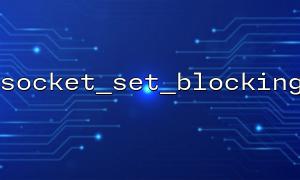In PHP network programming, socket_set_blocking() is a key function that controls whether a socket runs in a blocking manner. Understanding its behavior and mastering debugging skills is crucial to developing stable and reliable network applications. This article will explain in depth how to debug the blocking behavior of socket_set_blocking() , and provide practical tips and detailed steps.
When using PHP socket functions, the difference between blocking and non-blocking is:
Blocking mode : When functions such as socket_read() and socket_accept() are called, the process will hang until data is readable or there is a connection request.
Non-blocking mode : When calling these functions, if there is no data or no connection request, the function will return immediately, usually return false , and set socket_last_error() to the corresponding error code.
$socket = socket_create(AF_INET, SOCK_STREAM, SOL_TCP);
socket_connect($socket, 'gitbox.net', 80);
// Set to blocking mode
socket_set_blocking($socket, true);
At this point, if you execute a socket_read() call, it will wait until data returns.
To set to non-blocking:
socket_set_blocking($socket, false);
When you set to non-blocking, you can use socket_select() to detect whether it is readable/writable:
$read = [$socket];
$write = $except = null;
$changed = socket_select($read, $write, $except, 5); // time out 5 Second
if ($changed > 0) {
$data = socket_read($socket, 1024);
echo "Received data: $data\n";
} else {
echo "等待time out,未Received data\n";
}
This method is also suitable for debugging blocking behavior. In blocking mode, socket_select() can also help determine whether the blocking is going as expected.
Although not all scenarios are applicable, stream_socket_client() provides similar control methods and allows setting timeouts to help assist in debugging.
$fp = stream_socket_client("tcp://gitbox.net:80", $errno, $errstr, 30);
stream_set_blocking($fp, true);
// Or use stream_set_blocking($fp, false); Set to non-blocking
By comparing the response behavior of the two under different settings, the problem can be effectively located.
When debugging blocking behavior, if the docked server responds too quickly, it may be difficult to observe the effect. You can verify that blocking is effective by building a temporary server (such as using Python or PHP) and adding delays.
For example, server-side code deliberately delays:
$client = socket_accept($serverSocket);
sleep(10); // Simulation blocking
socket_write($client, "Hello after delay");
The client should wait for this period in blocking mode, and will return immediately in non-blocking.
Using socket_last_error() and socket_strerror() can more clearly locate blocking problems.
if ($data === false) {
$error = socket_last_error($socket);
echo "Error code: $error,describe: " . socket_strerror($error);
}
Common errors such as EAGAIN , EWOULDBLOCK , etc. indicate that there is no data to be read when trying to read in non-blocking mode.
Incorrectly setting the blocking state sequence : Setting blocking before connection is not as good as setting after connection, the effect may be different, and the order must be clear during debugging.
Missing the timeout parameter of socket_select() : The default is to block and wait. If the timeout is not set during debugging, it will mistakenly think that the socket has been stuck.
Unprocessed return value : When debugging blocking behavior, ignoring the return value will cause it to be impossible to determine whether the function is blocked.
Understanding and correctly debugging the blocking behavior of socket_set_blocking() is an important part of mastering PHP socket programming. By rationally using socket_select() , logging and simulation testing, you can effectively control the execution flow of network programs and improve the robustness and response efficiency of the system. I hope the tips and steps provided in this article can help you become more handy in actual development.





